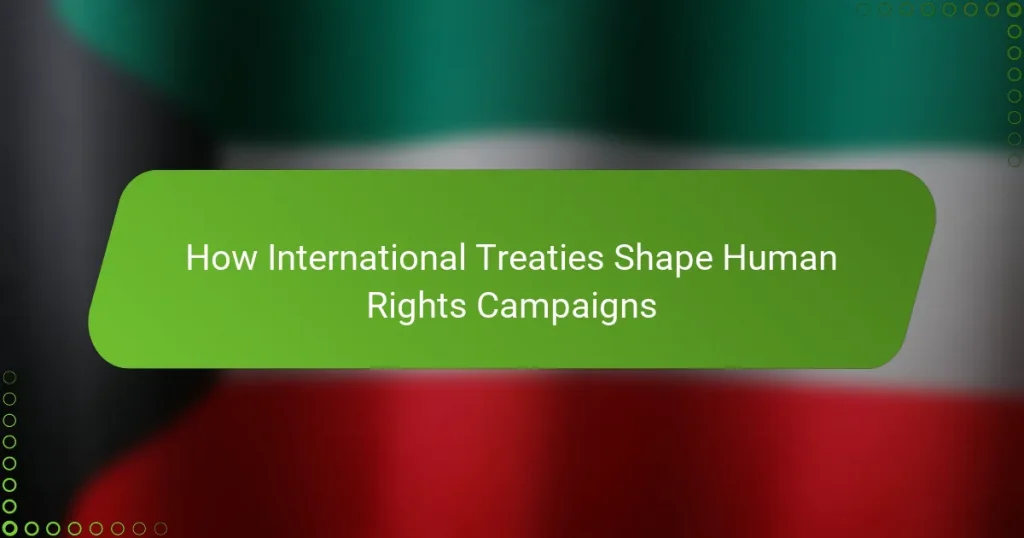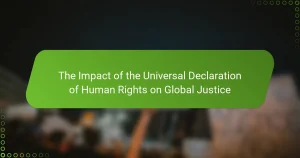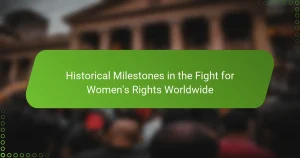International treaties play a crucial role in shaping human rights campaigns by establishing legal frameworks and standards that obligate signatory states to uphold human rights. These treaties, such as the Universal Declaration of Human Rights, provide a foundation for advocacy, accountability, and international scrutiny. However, challenges exist, including the lack of enforcement mechanisms and varying political will among countries. Case studies, such as the Convention on the Elimination of All Forms of Discrimination Against Women and the Convention on the Rights of the Child, demonstrate how ratification can lead to improved human rights practices. Furthermore, environmental treaties like the Paris Agreement illustrate the intersection of human rights and environmental advocacy, emphasizing the importance of treaties in promoting effective human rights campaigns.
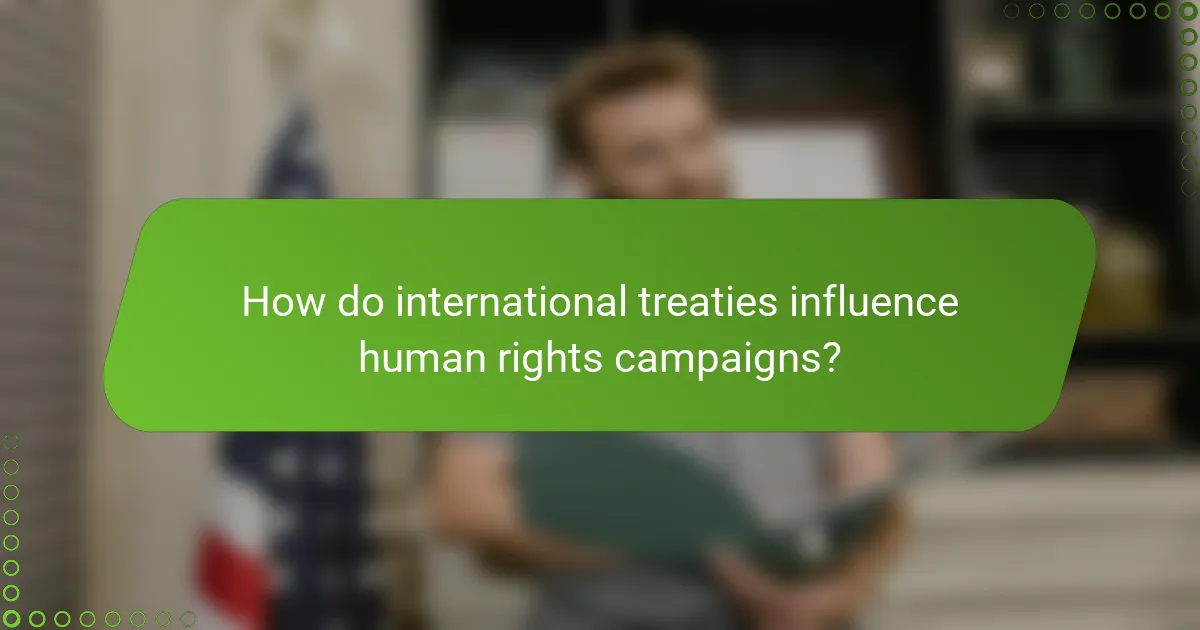
How do international treaties influence human rights campaigns?
International treaties significantly influence human rights campaigns by establishing legal frameworks and standards. These treaties provide a basis for advocacy and accountability. They create obligations for signatory states to uphold human rights. For example, the Universal Declaration of Human Rights sets fundamental rights recognized globally. Human rights organizations leverage these treaties to pressure governments for compliance. Additionally, treaties facilitate international scrutiny and reporting mechanisms. They enable NGOs to document violations and mobilize public opinion. The ratification of treaties often correlates with improved human rights practices in member states. Thus, international treaties are vital in shaping the agenda and effectiveness of human rights campaigns.
What are the key international treaties related to human rights?
The key international treaties related to human rights include the Universal Declaration of Human Rights (UDHR), the International Covenant on Civil and Political Rights (ICCPR), and the International Covenant on Economic, Social and Cultural Rights (ICESCR). The UDHR, adopted in 1948, sets out fundamental human rights universally recognized. The ICCPR, adopted in 1966, ensures the protection of civil and political rights. The ICESCR, also adopted in 1966, focuses on economic, social, and cultural rights. Other significant treaties include the Convention on the Elimination of All Forms of Discrimination Against Women (CEDAW) and the Convention on the Rights of the Child (CRC). These treaties collectively establish a comprehensive framework for human rights protection globally.
How do these treaties establish human rights standards?
International treaties establish human rights standards by creating legally binding obligations for signatory states. They outline specific rights and freedoms that must be respected and protected. These treaties serve as a framework for international law, guiding governments in their human rights practices. For instance, the Universal Declaration of Human Rights sets fundamental principles that all member states are encouraged to adopt. Additionally, treaties often include mechanisms for monitoring compliance and addressing violations. This accountability helps to reinforce the importance of human rights globally. For example, the International Covenant on Civil and Political Rights includes provisions for individual complaints, enhancing enforcement. Thus, treaties play a crucial role in shaping and standardizing human rights norms across nations.
What role do monitoring bodies play in enforcing these treaties?
Monitoring bodies oversee compliance with international treaties. They assess whether states adhere to treaty obligations. These bodies collect data, review reports, and conduct investigations. They facilitate dialogue between states and civil society. Monitoring bodies issue recommendations for improvement. They can also highlight violations to the international community. Their findings often influence public opinion and policy changes. This role is critical for promoting accountability and protecting human rights.
Why are international treaties important for human rights advocacy?
International treaties are crucial for human rights advocacy because they establish binding legal standards that protect individual rights. These treaties create a framework for accountability among nations. They obligate governments to uphold human rights principles, such as non-discrimination and freedom of expression. For example, the International Covenant on Civil and Political Rights outlines essential civil liberties. Treaties also provide mechanisms for monitoring compliance and addressing violations. The United Nations Human Rights Council oversees adherence to these agreements. By ratifying treaties, countries commit to improving their human rights practices. This commitment can lead to international pressure and support for local advocacy efforts.
How do treaties empower local human rights organizations?
Treaties empower local human rights organizations by providing a legal framework for advocacy. They establish international standards that local organizations can reference in their efforts. This legal backing enhances the credibility of local organizations. It also facilitates access to international resources and support. For instance, treaties like the International Covenant on Civil and Political Rights offer specific rights that local groups can advocate for. These treaties create accountability mechanisms for governments. Local organizations can use these mechanisms to hold authorities accountable for human rights violations. The presence of treaties often leads to increased funding and partnership opportunities. This empowers organizations to expand their reach and influence.
What impact do treaties have on government accountability?
Treaties enhance government accountability by establishing legal obligations that states must fulfill. These agreements often require transparency and adherence to human rights standards. For example, the International Covenant on Civil and Political Rights mandates signatory states to respect civil liberties. Failure to comply can lead to international scrutiny and potential sanctions. Additionally, treaties often create mechanisms for reporting and monitoring, which hold governments accountable. The Universal Periodic Review by the UN Human Rights Council is one such mechanism that evaluates state compliance. This process encourages governments to improve their human rights records. Overall, treaties serve as tools for promoting accountability in governance.
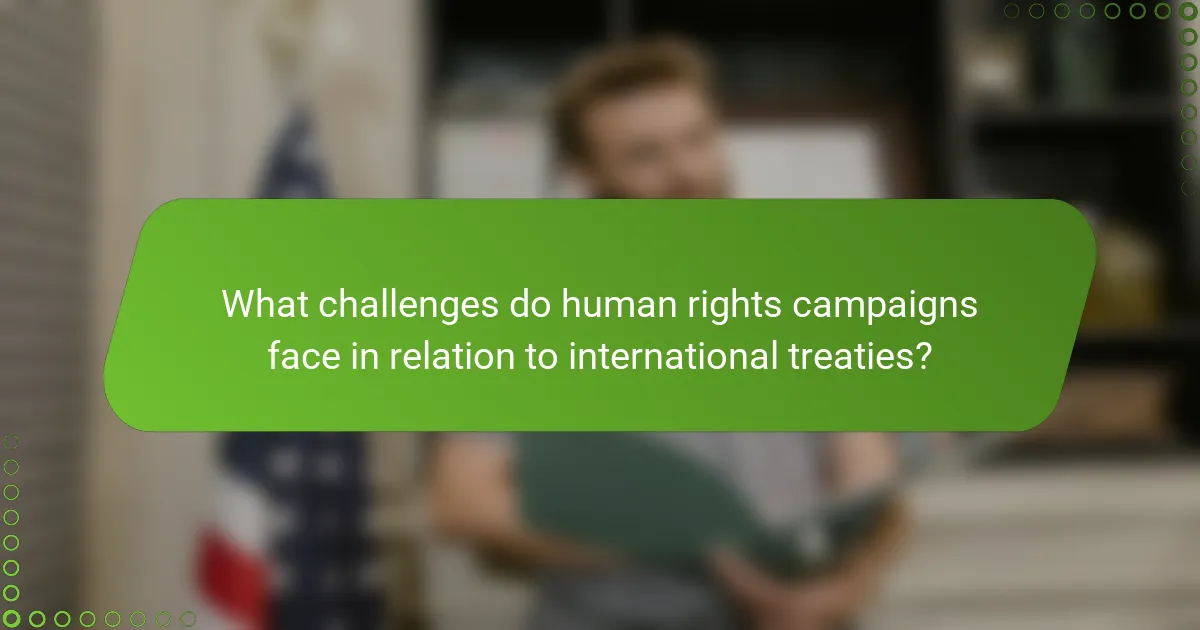
What challenges do human rights campaigns face in relation to international treaties?
Human rights campaigns face significant challenges in relation to international treaties. One major challenge is the lack of enforcement mechanisms within many treaties. For example, the International Covenant on Civil and Political Rights relies on state parties for compliance, which can lead to violations without repercussions. Additionally, differing interpretations of treaty obligations among countries complicate uniform implementation. Political will varies widely, impacting the commitment to uphold human rights standards. Furthermore, some states may prioritize national interests over treaty obligations, undermining the effectiveness of campaigns. Lastly, there is often limited funding and resources for organizations advocating for treaty adherence, hindering their efforts to promote human rights.
How do political factors affect the implementation of treaties?
Political factors significantly influence the implementation of treaties. Governments may prioritize domestic interests over international obligations. Political stability affects a country’s commitment to uphold treaty terms. Changes in leadership can lead to shifts in treaty enforcement. National public opinion can pressure governments to comply or withdraw from agreements. Legislative bodies often need to ratify treaties, impacting their effectiveness. Geopolitical relationships also play a role in treaty adherence. For instance, countries may ignore treaties if they conflict with strategic alliances or national security interests.
What are the consequences of non-compliance with international treaties?
Non-compliance with international treaties can lead to significant political, economic, and legal consequences. States may face diplomatic isolation from the international community. This isolation can result in reduced foreign aid and trade sanctions. Legal repercussions may include being taken to international courts, such as the International Court of Justice. Non-compliance can also undermine a country’s credibility and influence in global affairs. For example, the United States faced criticism for its withdrawal from the Paris Agreement, impacting its global standing on climate issues. Furthermore, non-compliance can escalate tensions between nations, potentially leading to conflicts.
How do cultural differences influence treaty effectiveness?
Cultural differences significantly influence treaty effectiveness by affecting negotiation styles and implementation practices. Different cultures prioritize various values, such as individualism versus collectivism, which shapes their approach to treaties. For example, cultures that emphasize collectivism may focus on community consensus, impacting how agreements are reached and honored. Misunderstandings in communication styles can lead to misinterpretations of treaty obligations. Additionally, cultural norms influence the perceived legitimacy of treaties within a society. Historical examples show that treaties often fail when cultural contexts are ignored, such as the Kyoto Protocol, which faced challenges due to differing economic priorities among nations. Thus, understanding cultural differences is crucial for enhancing treaty effectiveness in international relations.
What strategies can human rights campaigns use to leverage treaties?
Human rights campaigns can leverage treaties by using strategic advocacy, legal frameworks, and public awareness. Advocacy efforts can focus on mobilizing public support and influencing policymakers. Campaigns can utilize existing legal frameworks established by treaties to hold states accountable for violations. Public awareness campaigns can educate citizens about treaty obligations and their rights under these treaties. Collaborating with international organizations can amplify the impact of these strategies. For instance, the Universal Declaration of Human Rights serves as a foundational treaty that campaigns can reference to demand compliance. Historical examples, such as the success of the Convention on the Elimination of All Forms of Discrimination Against Women, demonstrate how campaigns effectively used treaties to influence national laws.
How can advocacy groups effectively use treaty mechanisms?
Advocacy groups can effectively use treaty mechanisms by leveraging international legal frameworks to hold governments accountable. They can identify specific treaty obligations that relate to their causes. By documenting violations of these obligations, groups can present evidence to international bodies. This evidence can compel action from treaty monitoring committees. Advocacy groups can also engage in shadow reporting to provide alternative perspectives to official government reports. Collaborating with other organizations enhances credibility and amplifies their message. They can utilize public campaigns to raise awareness and pressure governments to comply with treaty commitments. Historical examples, such as the role of NGOs in the Convention on the Rights of the Child, demonstrate the effectiveness of this approach.
What role does public awareness play in treaty-based campaigns?
Public awareness is crucial in treaty-based campaigns as it drives engagement and support. Increased awareness educates the public about treaty objectives and their implications. This knowledge can mobilize communities to advocate for human rights. For instance, campaigns like the International Campaign to Ban Landmines gained traction through public awareness efforts. Studies show that informed citizens are more likely to participate in advocacy activities. Public awareness also pressures governments to adhere to treaty obligations. Consequently, it fosters accountability and transparency in the implementation of human rights treaties.
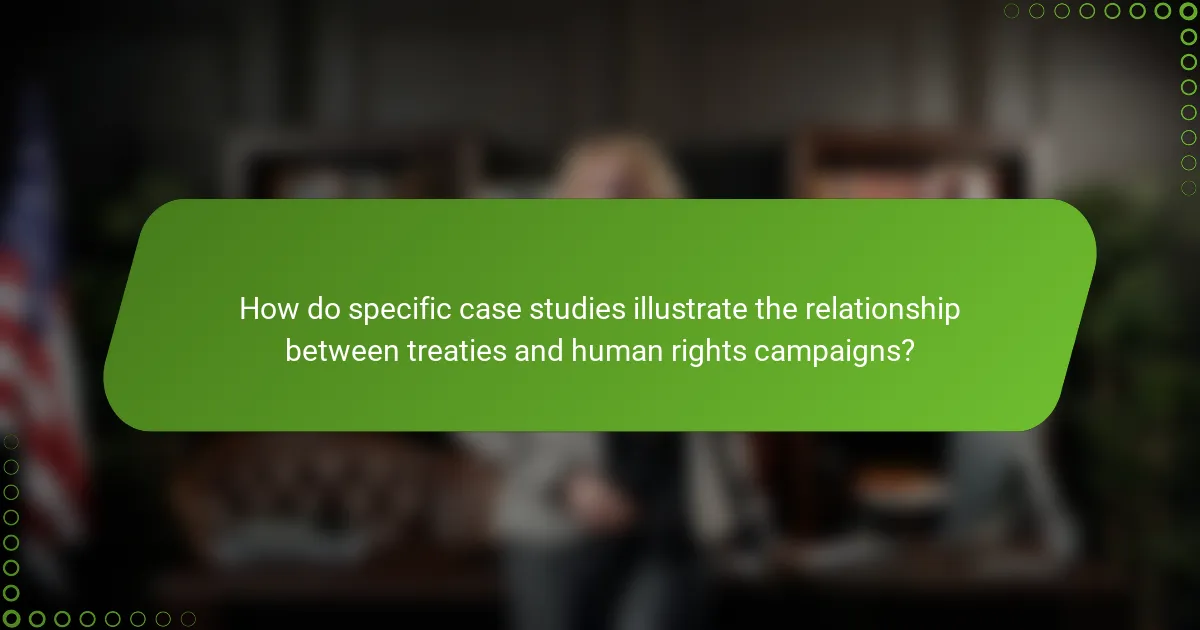
How do specific case studies illustrate the relationship between treaties and human rights campaigns?
Specific case studies demonstrate the relationship between treaties and human rights campaigns through practical examples. The Convention on the Elimination of All Forms of Discrimination Against Women (CEDAW) serves as a pivotal case. Countries ratifying CEDAW often see increased advocacy for women’s rights. This treaty provides a framework that human rights organizations leverage to push for reforms.
Another example is the Convention on the Rights of the Child (CRC). Ratifying states are held accountable for children’s rights, prompting campaigns for policy changes. Reports from organizations like UNICEF show that CRC ratification correlates with improved child welfare policies.
The Paris Agreement showcases how environmental treaties intersect with human rights. Campaigns for climate justice often reference this treaty to advocate for vulnerable populations. Research indicates that nations committed to the Paris Agreement are more likely to implement protective measures for affected communities.
These case studies illustrate that treaties not only establish legal obligations but also empower human rights campaigns to effect change.
What are some notable examples of successful treaty implementation?
The Paris Agreement is a notable example of successful treaty implementation. Adopted in 2015, it aims to limit global warming to below 2 degrees Celsius. As of 2023, over 190 countries have ratified the agreement. These nations are working to meet their nationally determined contributions (NDCs) to reduce greenhouse gas emissions. Another example is the Convention on the Rights of the Child, adopted in 1989. It has been ratified by 196 countries, making it one of the most widely accepted treaties. This convention has led to significant improvements in children’s rights and welfare globally. The Montreal Protocol is also significant, as it successfully phased out substances depleting the ozone layer. Implemented in 1989, it has resulted in a substantial recovery of the ozone layer. Each of these treaties demonstrates effective international cooperation and commitment to shared goals.
How did specific treaties lead to tangible human rights improvements?
Specific treaties have led to tangible human rights improvements by establishing legal frameworks that protect individual rights. The Universal Declaration of Human Rights, adopted in 1948, set global standards for human rights. This treaty influenced many national constitutions and laws, promoting the protection of civil liberties. The International Covenant on Civil and Political Rights, effective since 1976, obliges signatory states to respect and ensure rights like freedom of speech and assembly. Compliance mechanisms, such as periodic reviews by the Human Rights Committee, hold countries accountable for their human rights practices. The Convention on the Elimination of All Forms of Discrimination Against Women, established in 1981, has led to significant advancements in gender equality laws worldwide. Countries that ratified this treaty have implemented policies to combat discrimination and violence against women. These treaties have provided a basis for advocacy and legal action, resulting in improved human rights protections globally.
What lessons can be learned from unsuccessful treaty efforts?
Unsuccessful treaty efforts reveal critical lessons about negotiation and implementation. They highlight the importance of inclusive dialogue among all stakeholders. A lack of consensus often leads to failure. Historical examples, such as the Kyoto Protocol, demonstrate that insufficient commitment from major countries can undermine agreements. Additionally, unsuccessful treaties can expose the necessity for clear enforcement mechanisms. Without these, compliance is often weak. They also show the need for adaptability in addressing emerging issues. Treaties must evolve to remain relevant in changing political landscapes. Lastly, they underscore the significance of public support in achieving lasting agreements.
What best practices can human rights campaigns adopt when working with international treaties?
Human rights campaigns can adopt several best practices when working with international treaties. First, they should thoroughly understand the treaties relevant to their cause. This includes knowing the obligations and rights established by these agreements. Second, campaigns should engage in coalition-building with other organizations. Collaborative efforts can amplify voices and increase influence. Third, they should utilize data and case studies to support their advocacy. Concrete evidence strengthens arguments and highlights the need for action. Fourth, campaigns should focus on awareness-raising strategies. Educating the public and stakeholders about treaty implications is essential. Fifth, they should monitor compliance with treaties. Tracking state adherence helps identify gaps and push for accountability. Lastly, campaigns should advocate for the incorporation of treaty provisions into national legislation. This ensures that international commitments translate into domestic law. These practices enhance the effectiveness of human rights campaigns in leveraging international treaties for advocacy.
How can campaigns effectively engage with treaty monitoring bodies?
Campaigns can effectively engage with treaty monitoring bodies by submitting shadow reports. Shadow reports provide alternative information to official state reports. These reports highlight discrepancies and advocate for specific issues. Additionally, campaigns can participate in consultations and meetings organized by monitoring bodies. This participation allows direct interaction with treaty experts. Engaging in dialogue can influence recommendations made by these bodies. Campaigns should also build coalitions with other organizations for a stronger voice. Collective advocacy can enhance credibility and impact. Regular follow-up on recommendations is essential for accountability. This approach ensures ongoing dialogue and reinforces the campaign’s commitment to human rights.
What resources are available for groups working on treaty advocacy?
Groups working on treaty advocacy can access various resources. Key resources include toolkits, guidelines, and training workshops. Organizations like the United Nations provide comprehensive materials on treaty processes. The International Human Rights Clinic offers advocacy training tailored for treaty engagement. Online platforms host webinars and forums for knowledge exchange. Additionally, academic journals publish research on treaty impacts and strategies. These resources enhance the capacity of advocacy groups to influence treaty negotiations and implementation.
International treaties are pivotal entities that establish legal frameworks and standards influencing human rights campaigns. This article examines how treaties like the Universal Declaration of Human Rights and the International Covenant on Civil and Political Rights create obligations for states, facilitate accountability, and empower local organizations. It also discusses the role of monitoring bodies in enforcing compliance, the challenges faced in treaty implementation, and the strategies human rights campaigns can adopt to leverage these treaties effectively. Through case studies, the article illustrates the tangible improvements in human rights resulting from successful treaty implementation and highlights best practices for advocacy groups working within this framework.
